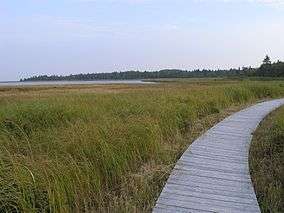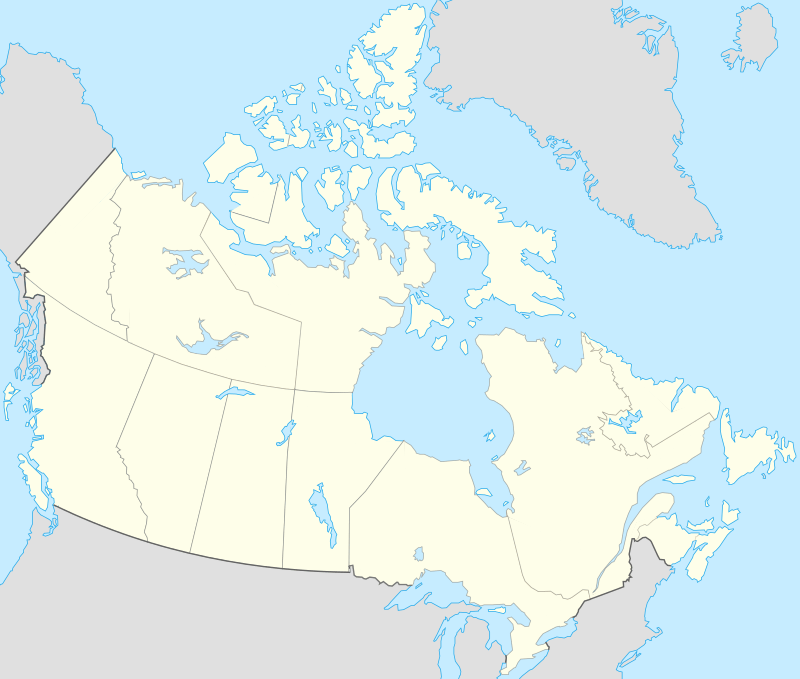Kouchibouguac National Park
Kouchibouguac National Park (/kuːʃɪbuːˈɡwɑː/)[2] is located on the east coast of New Brunswick, in Kouchibouguac. The park includes barrier islands, sand dunes, lagoons, salt marshes and forests. It provides habitat for seabirds, including the endangered piping plover, and the second largest tern colony in North America. Colonies of harbour seals and grey seals also inhabit the park's 25 kilometres (16 mi) of sand dunes. It is also home to the extremely rare and fragile Gulf of St. Lawrence aster, though in 2006, storms eradicated most of the asters' colonies. The park's size is 238 km2 (92 sq mi). Recreational activities in the park include swimming, cycling and hiking. In recent news, the park has reported sightings of the fisher marten in the area, making it one of the few places in New Brunswick that have fisher populations. The park's various public activities attract thousands of visitors each year. Kouchibouguac offers a range of activities, from a river adventure in a voyageur-style canoe, to going seal watching, to a talk about Mi'kmaq band governments. The park is also home to the popular Kelly's Beach.
| Kouchibouguac National Park Parc national de Kouchibouguac (French) | |
|---|---|
IUCN category II (national park) | |
 Boardwalk over a salt marsh | |
 Location of Kouchibouguac National Park in Canada | |
| Location | Kouchibouguac, New Brunswick, Canada |
| Coordinates | 46°50′59″N 64°58′01″W |
| Area | 238 km2 (92 sq mi) |
| Established | 1969 |
| Visitors | 159,398[1] (in 2015-16) |
| Governing body | Parks Canada |
History
The park was founded by in 1969 in order to set aside sensitive sand dunes and bogs. The rules of the time dictated that all permanent residents had to be removed for a park to be created. These residents were mostly Acadians, whose ancestors had been deported. As a result, Parks Canada encountered great difficulty expropriating land from numerous land owners who lived in seven communities (approximately 215 families, including over 1200 individuals). These seven communities were Claire-Fontaine, Fontaine, Rivière au Portage, Kouchibouguac, Guimond Village, Cap St-Louis, and Saint-Olivier. The residents were generally seen as so poor that government officials believed they would benefit from having to start their lives again elsewhere. The government created courses with the intent that people might lead more productive lives. Government officials believed that they were rehabilitating the people by evicting them. The residents resisted this eviction, shutting down the park on several occasions. The most notable of these was Jackie Vautour, whose home was bulldozed in 1976, but who returned to squat there two years later, where he still remains.[3] Vautour's decades-long struggle has turned him into a folk hero.
Kelly's Beach, a very long sand dune, is a popular attraction along with a number of bogs, a boardwalk trail, eight hiking trails, a network of bicycle trails, two campgrounds, canoe and boat launch and the Cap-St-Louis fishing port. But this beauty cannot eliminate the pain experienced by the former residents, whose story is now told in a permanent exhibit at the park's Visitor Centre.
The park has a Mi'kmaq name which is reflected in the name of the Kouchibouguac River. The river's name means "river of the long tides" in Mi'kmaq. The decision to name the park in this manner did not sit well with many local residents, Acadians who wanted a name that better reflected their identity. Many wanted the park to be called Claire-Fontaine, after one of the communities that was destroyed.
As a result of the resistance to the park, Parks Canada changed its rules, so no one would ever again experience forced removal.
Other rivers that flow through the park include the:
- Black River
- Kouchibouguacis River
- Saint-Louis River
- Portage River
The story of the park had been the subject of two big budget documentaries. In addition, the park was the subject of a short film in 2011's National Parks Project, directed by Jamie Travis and scored by Casey Mecija, Don Kerr and Ohad Benchetrit. There is also a website which provides access to 26 video portraits of the people removed from their land as part of the process of creating the park.[4]
Fauna
Mammal species that inhabit on the land are raccoon, bobcat, lynx, moose, species of bats, timber wolf, coyote, black bear, beaver, marten, species of shrews, river otter, porcupine, muskrat, species of mice, woodchuck, mink, striped skunk, and snowshoe hare. Bird species of this park are bald eagles, a number of geese, woodpecker, three species of falcons, ducks, loons, a variety of owls, and hawks. Marine animals that inhabit offshore are a variety of seals, dolphins, porpoises, and variety of whales.
See also
- National Parks of Canada
- List of parks in New Brunswick
- List of trails in New Brunswick
- List of beaches in New Brunswick
References
- Parks Canada Visitation Records Accessed November 17, 2016
- Parks Canada (2017-07-26). Parks Can Can Canada 2017. Retrieved 2019-05-19.
- Ronald Rudin, "Kouchibouguac: Representations of a Park in Acadian Popular Culture," in Claire Campbell, ed., 'A Century of Parks Canada' (University of Calgary Press, 2011), pp 205-33.
- Returning the Voices to Kouchibouguac National Park. Returningthevoices.ca. Retrieved on 2013-08-09.
| Wikimedia Commons has media related to Kouchibouguac National Park. |